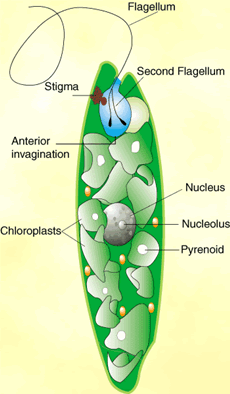 |
| Euglenoids |
Organisms called euglenoids, the algal phylum Euglenophyta in the kingdom Protista, make up a large group of common microorganisms numbering between 750 and 900 known species.
Euglenoids can be found in both fresh and stagnant water. Some genera of euglenoids can also be found in marine habitats. Euglena and Phacus are representative common genera. Euglenoids are unicellular, except for those of the colonial genus Colacium.
Because euglenoids have flexible cell coverings, move about freely, and ingest their food through a structure called a gullet, many scientists have classified the euglenoids as animals. Some species of euglenoids, however, have chloroplasts and are able to supply at least some of their food needs through photosynthesis.
  |
Structure
The cells of most euglenoids are spindle-shaped and do not have cell walls or other rigid structures covering the plasma membrane. However, one genus, Trachelomonas, has a covering called a lorica, which is similar to a cellwall and contains iron and magnesium minerals.
Spiral strips of protein that originate in the cytoplasm support the plasma membrane, creating a structure called a pellicle. The pellicle may be either flexible or rigid. Euglenoids with a flexible pellicle are able to change their shape, which helps them move about in muddy habitats.
 |
| Euglenoid structure |
Other features of euglenoids include the presence of a gullet, or groove, in many species, through which food is ingested. About one-third of the euglenoids have disk-shaped chloroplasts and can supply at least part of their own food through photosynthesis. Even these photosynthetic euglenoids are capable of ingesting dissolved or particulate food through their gullet if necessary.
Areddish-colored structure called an eyespot, or stigma, is located in the cytoplasm near the base of the flagella. This eyespot acts as a light-sensing device. The eyespot appears to be connected to the flagellum by special strands of cytoplasm, which may serve to transmit signals from one organelle to the other.
Euglenoid cells also contain a contractile vacuole. The contractile vacuole functions as a pump that removes excess water from the interior of the euglenoid cell. The water is pumped out of the cell through the reservoir. A new contractile vacuole is formed after each discharge of water.
Pigments and Food Reserves
Some scientists believe that similarities between euglenoids and green algae indicate that the chloroplasts of euglenoids originated in endosymbiotic green algae.
The chloroplasts of both euglenoids and green algae contain chlorophyll a and chlorophyll b. Euglenoids and green algae also have some carotenoid pigments in common, although euglenoids contain two pigments derived from carotenoids that are not found in either green algae or the higher plants.
While there are some similarities in pigmentation between euglenoids and green algae, the two groups have different food reserves. Green algae have food reserves of starch, while euglenoids have a carbohydrate food reserve called paramylon, which normally is present in the form of small, whitish bodies of varying shapes scattered throughout the cell.
Reproduction
Reproduction in euglenoids takes place by mitotic cell division. Even as the euglenoids are swimming about, the cell begins to divide, starting at the end of the cell,where the flagellumis located.
Eventually the cell splits lengthwise, forming two complete cells. Unlike the nuclear membrane in most organisms, the membrane surrounding the euglenoid nucleus does not breakdown during mitosis.
Many scientists believe that euglenoids do not reproduce sexually; meiosis and gametogenesis have never been observed in euglenoids. Some scientists suspect sexual reproduction must occur, even though it has not been seen.
Other scientists believe that even individuals of the same euglenoid species have different amounts of DNA in their nuclei, which would preclude meiosis. Still others believe that euglenoids branched off the main evolutionary lines of protoctists before sexual reproduction had evolved.
Some species of euglenoids have developed the capacity to make thick-walled resting cells. Inside these cells, the euglenoids can wait out unfavorable environmental conditions. When conditions are favorable, the organisms break out of their resting cells and resume their normal shapes and activities.